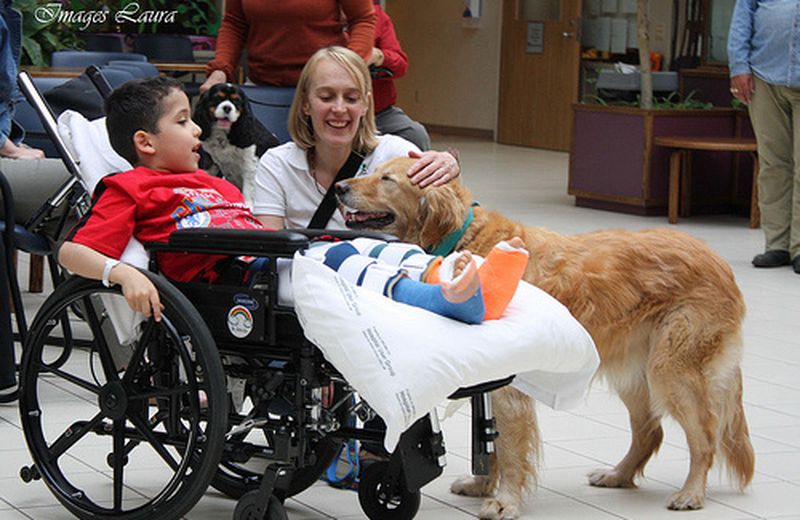Become a pet therapist
Pet therapy is a group work. Patient, animal, doctor, psychologist, veterinarian, ethologist, trainer and therapist. But how does one become a pet therapist and what does this approach consist of?

A journey into Pet therapy
The term Pet therapy, or AAT ( Animal-Assisted Therapy ), defines a gentle therapeutic system focused on the interaction between humans and animals . The idea of using some animals to improve the quality of convalescence of the sick or more simply the daily reality of disabled people arises from the observation of the effects deriving from the interaction between sick people and the presence of an animal. As a gentle therapy to complement traditional therapies, pet therapy is aimed at patients suffering from learning and attention disorders, psychomotor disorders, anxious and depressive neuroses, Down syndrome, West’s syndrome, autism, senile dementias, psychotic pathologies and multiple sclerosis.But who are the pet therapy operators?
First of all, dogs , cats , horses and dolphins . In many cases, being close to a dog or cat is shown to have an additional effect to that of many medications or other conventional therapies. Pet therapy is used as a game , for socialization, to encourage communication and the development and / or strengthening of spheres such as responsibility and self-esteem.
The difference between man and animal lies in prejudice . The animal relates to a human being in a simple way. The patient therefore interacts with a living being, considering it equal to himself, without judgments, managing to relate in a healthy way. This allows you to re-evaluate your socialization patterns. Those who want to become a pet therapist must therefore interact with the patient and with an animal, but not only. You will need to seek advice and support from other professionals .
the Pet therapist and the working group
Becoming a pet therapist means collaborating with a team of different professionals: doctor, psychologist, veterinarian, ethologist and instructor. Since pet therapy is carried out on people suffering from various pathologies relating to physical and mental aspects, the presence of a doctor or psychologist is essential first of all . It is up to the latter, naturally availing themselves of the advice of other professionals, to evaluate and indicate how to use the animals. If patients have physical handicaps, the support of the rehabilitation therapist is also needed .
The role of the veterinarian is fundamental . In the case of pet therapy, the veterinarian who collaborates with the working group is required to have specific training in the sector. First of all, he must select the most suitable animal for the type of therapy to be implemented, then constantly and accurately monitor its state of health, not only physical but also psychological. The animals are subjected to periodic checks, paying particular attention to clinical signs relating to zoonoses (especially parasitic and mycosis) which, being transmissible to humans, could compromise pet therapy. Finally, the veterinarian must check over time how the animal can handle the work undertaken. In any case, animals that show symptoms of disease or signs of discomfort are excluded from the pet therapy program started.
The pet therapist contributes to the choice of the animal based on an accurate analysis of the attitudinal and behavioral characteristics. Subsequently, it is responsible for educating patients (where possible), their family members and other operators, about the behavior of the animals used, the type of intervention they are able to perform and, above all, to what amount of work they can to sustain. Finally, you provide criteria for evaluating and safeguarding the welfare of the “working” animal.
Become a pet therapist
Becoming a pet therapist is not that simple. First of all, it is necessary to choose the field of intervention of the AAT , which can be medical-hospital, socio-educational, rehabilitation and disability. For each of these there are special pet therapist courses. Precisely because pet therapy depends on team work, there cannot be an educational training path that can define a single specialist professionalism referring to pet therapy as a whole.
Basically, however, for those who want to become a therapist it is necessary to attend a course for pet therapist, at the end of which there is an internship and the issue of a certificate of attendance.
In Italy , interest in pet therapy activities has grown and the demand in the area has increased. Associations, rehabilitation centers, schools and retirement homes are structures interested in new support therapies, new recreational modalities to be included in their programs to increase the quality of life within their structures. The recognition of pet therapy took place with the Prime Minister’s Decree of February 28, 2003, which acknowledges the agreement between the Ministry of Health , the Regions and the Autonomous Provinces , regarding the welfare of pets and pet therapy. The attention paid at the legislative level pet therapy allows the discipline a scientific and procedural dignity also in Italy. The attempt to regulate the AAT programs at a national level frees these contributions from the ‘do-it-yourself’ forms.
Image | Khaleeka




























+ There are no comments
Add yours